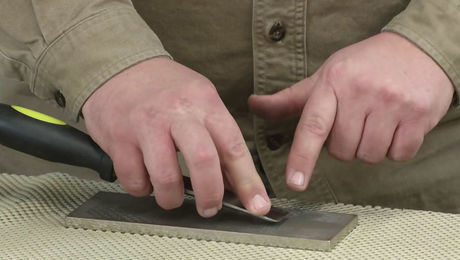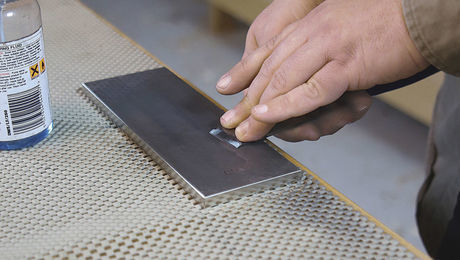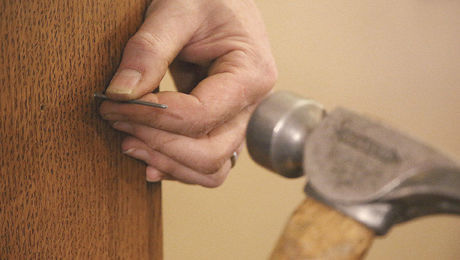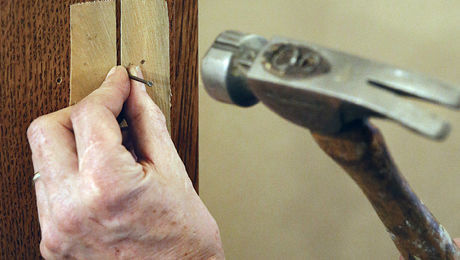Electrical Subpanel Safety Tips: What You Can and Can’t Touch When Installing Circuit Breakers
EDITOR’S NOTE:
The subpanel that Brian is working on has been newly added to power a garage shop.
It has NOT been connected to the main panel yet and therefore there is absolutely NO threat of electrocution. This is why Brian is not concerned with touching the contacts inside the subpanel with his fingers. We should have asked him to point with an insulated screwdriver.
When working on any type of electrical panel that is connected to a power supply, always err on the side of caution. Use a volt meter to check that the wires and bus bars are not energized.
—————————————————————-
Working Safe in an Electrical Subpanel
With Brian Walo
Before you add or repair any electrical cicuits in a home, you should be familiar with the layout of the main panel or subpanel that feeds power to the house. In this video, electrician Brian Walo gives a quick overview of where the power enters a subpanel, and what you need to turn off to safely connect or disconnect a circuit breaker.
This is a free companion video to our How To install a Subpanel member video series, which shows all the steps you’ll need to get power to your new kitchen, garage workshop, finished basement, or any other remodel or addition.
VIDEO TRANSCRIPT:
Save your life instead of saving time
You really shouldn’t be working in a live panel no matter what. It takes two seconds to turn off the main breaker. However, that doesn’t give you complete freedom to do whatever you want in here; there are still some dangerous parts. In a main panel, where you’ve got a main circuit breaker and some large wires coming in, even if you shut off the breaker, the two main poles are still going to be carrying electricity. If the main breaker were on, all of the exposed stabs for the bus bar are all going to be carrying electricity. So you’re not going to want to touch any of that. The neutral is also a potential shock point if the power is on. Try to avoid touching any of the incoming service lines.
Breakers should cut the power, but always double-check
Now, once the main circuit breaker is off, all of thes bus bars have been de-energized, but always test to be sure. If you happen to strike one of the bars after the main cicuit is off, you’ll actually be OK. Same goes for the terminals on the breakers themselves; they’re like light switches. When one is on, the connection is hot. When you turn it off, it’s dead.



























View Comments
I would recommend using an insulated screwdriver to point out items in a panelboard, not your finger.
Best to leave to work on panel to pros. Most of us hate to touch much inside a panel box. This was a nice and succinct discussion of "dos" and dont's". Thank you.
When going into a panel, take a moment to see if all the wiring inside is correct and is in the right places. You have no idea what the home owner has done, please believe me I have seen some of the worst stuff that works but is not code or right and is an accident waiting to happen.
How lame was that video?? It told us nothing and imparted not a whit of potential protective advice. Sorry, but two thumbs down.
Probably one of the shortest and most useless how-to videos I have ever watched. This thing might actually inspire someone to poke fingers around live wires (possibly in a darkened room becuse he turned the wrong breaker off) not realising what the main feed looks like. Leave this to an electrician.
This video reminds me of my very first shop teacher Mr Nalepka in the sixties who in his zeal to teach students what not to do [inhaling while causing plumes of sawdust to be airborne] demonstatated that very hazzard by using sander without face mask and needed to be taken to infirmiry for respirary distress. Granted he mentions "if the power were on" but the mans fingers are all over the place. That what laser pointers are for. Demonstrate safty culture by keeping one hand in your pocket and the other away from hot terminals.
I could use a little more info. For example, I recently moved a ceiling light over our stair-well one foot over to an adjacent stud to make room for a heat-pump that we had recently installed professionally. I first needed to disconnect it from the ceiling fixture so I made sure the switch was off, but did not turn off the breaker because I needed light from other sources on the circuit to see what I was doing. A dead light, though, means there's no power going through it, right? I disconnected the light without difficulty, but before redoing the connection I decided to test the line with a Fluke meter. I was surprised to see that the meter read 66.7 volts AC! It wasn't millivolts, it wasn't fluctuating in the low ranges, it was a steady 66.7 volts AC. To be sure no real current was flowing I touched the exposed wire ends to the prongs of a small 20W night light and the filament stayed dark. Since I was 12 feet in the air on an aluminum ladder I decided not to test things further and simply made sure I didn't touch the exposed ends while working on the wires. After the work was done the light functioned just fine. So how is it possible that a dead line can measure such a high voltage and not be a hazard? The house is one year old, built by a contractor, and the service is 100V 50 Hz (Tokyo Japan).
kmpres, I believe what you saw can be caused by induction (or some kind of electromagnetic effect). For example, if the wire serving this light runs parallel to other live wires, I believe you will get some measurable voltage. However, you will not get much or any measurable current because the parallel wires are some magnitudes shorter of what you would find in a transformer.
Also, please note that just because the light is off, this does not mean that there are no hot wires in the light fixture. The switch might be installed in the neutral wire (relative to the light fixture). So while no current can flow through the light because the neutral wire is interrupted, if you touched the hot wire you personally plus your aluminum ladder would "close" the circuit against ground. Not sure if such wiring is against (Japanese) code but would you trust your contractor and bet your life on it? Therefore, ALWAYS turn off the breakers and get an extension cord and work light.
No mention, before he touched the mains, that they're not engergized. Not a good example.
IMO, stronger mention of the fact that the feeds themselves were unpowered would have made this waaaay more effective.
This video is not up to Fine HomeBuilding's usual standards.
This is NOT what you'd call "Fine Homebuilding". In fact, it seems to be more a "How to hurt yourself by following my example"! FineHomebuilding should take this video down before someone gets injured and sues them for sloppiness and bad example. The dope in the video touches two live wires (the feeds by the electric company that cannot be shut off by the homeowner) by his own admission. Shame on FineHomebuilding.com --- they can do better and usually do. This was awful. Do everyone a favor and leave a comment here telling FH to kill off this site -- quickly.
This video is shakey at best for the average home owner.
The narrator is dealing with a sub-panel as opposed to a SEP. That fact is briefly mentioned, but I'm not sure that the difference between the two panel arrangements will truly be comprehended.
To further confuse the home owner, this sub-panel is equipped with a main breaker (as opposed to main lug configuration) making it "look like" a SEP which is never totally dead unless the meter has been pulled.
Obviously, the supplying breaker at the SEP is turned off otherwise we would have seen some interesting reactions.
A bit of checking that the panel was truly de-energized at the very beginning of the video would have made it considerably more useful and informative. Volt meter on the mains or even a non-contact voltage detector would suffice.
Safety first!
Ditto dirkfaegre's comment. This video is potentially VERY dangerous. It should be pulled immediately and re-done properly.
The idea is a good one; the execution could lead to electro-cution.